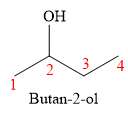
Concept explainers
(a)
Interpretation:
The IUPAC name for the given compound is to be written.
Concept introduction:
In naming organic compounds, first identify the longest carbon chain or a ring containing the
Answer to Problem E.1P
The IUPAC name for the given compound is
Explanation of Solution
The given compound is

In this compound, the functional group is alcohol. The parent is a four carbon atoms chain, therefore, the parent name is butanol. The carbon atoms in the parent chain are numbered starting from the carbon where the functional group gets the lowest number.

In the above compound, the functional group

IUPAC name for the given compound is written.
(b)
Interpretation:
The IUPAC name for the given compound is to be written.
Concept introduction:
In naming organic compounds, first identify the longest carbon chain or a ring containing the functional group. Name the parent chain or a ring by replacing ‘e’ from the name of the parent alkyl chain by ‘ol’ for alcohol functional group. Number the carbon chain in a way that the functional group gets the lowest number.
Answer to Problem E.1P
The IUPAC name for the given compound is
Explanation of Solution
The given compound is

In this compound, the functional group is alcohol. The parent is of four carbon atoms chain, therefore, the parent name is butanol. The carbon atoms in the parent chain are numbered starting from the carbon where the functional group gets the lowest number.
![]()
In the above compound, the functional group

IUPAC name for the given compound is written.
(c)
Interpretation:
The IUPAC name for the given compound is to be written.
Concept introduction:
In naming organic compounds, first identify the longest carbon chain or a ring containing the functional group. Name the parent chain or a ring by replacing ‘e’ from the name of the parent alkyl chain by ‘ol’ for alcohol functional group. Number the carbon chain in a way that the functional group gets the lowest number.
Answer to Problem E.1P
The IUPAC name for the given compound is
Explanation of Solution
The given compound is

In this compound, the functional group is alcohol. The parent is a ring of three carbon atoms, so, the parent name is cyclopropanol. The carbon atoms in the parent ring are numbered starting from the carbon where the functional group gets the lowest number.

In the above compound, the functional group

IUPAC name for the given compound is written.
Want to see more full solutions like this?
Chapter E Solutions
Get Ready for Organic Chemistry
- Is (CH3)3NHBr an acidic or basic salt? What happens when dissolved in aqueous solution? Doesn't it lose a Br-? Does it interact with the water? Please advise.arrow_forward© Macmilla Finish resonance structure 3 Select Draw Templates More C H N 0 H H S Erase Which structure is the most stable (lowest energy) resonance contributor? The structure with the positive charge on nitrogen and negative charges on oxygen and sulfur. All structures are equal in stability. The structure with the positive charge on nitrogen and negative charges on sulfur and carbon. The structure with the positive charge on nitrogen and negative charges on oxygen and carbon. Q2Qarrow_forwardThree pure compounds are formed when 1.00 g samples of element x combine with, respectively, 0.472 g, 0.630 g, and 0.789 g of element z. The first compound has the formula x2Z3. find the empricial formula of the other two compoundsarrow_forward
- Draw the product and the mechanism A. excess H*; 人 OH H*; B. C. D. excess OH ✓ OH H*; H₂O 1. LDA 2. H*arrow_forwardIn reactions whose kinetic equation is v = k[A]m, the rate coefficient k is always positive. Is this correct?arrow_forwardIf the concentration of A decreases exponentially with time, what is the rate equation? (A). -d[A] (B). dt d[A] = k[A] e-kt dtarrow_forward
 ChemistryChemistryISBN:9781305957404Author:Steven S. Zumdahl, Susan A. Zumdahl, Donald J. DeCostePublisher:Cengage Learning
ChemistryChemistryISBN:9781305957404Author:Steven S. Zumdahl, Susan A. Zumdahl, Donald J. DeCostePublisher:Cengage Learning ChemistryChemistryISBN:9781259911156Author:Raymond Chang Dr., Jason Overby ProfessorPublisher:McGraw-Hill Education
ChemistryChemistryISBN:9781259911156Author:Raymond Chang Dr., Jason Overby ProfessorPublisher:McGraw-Hill Education Principles of Instrumental AnalysisChemistryISBN:9781305577213Author:Douglas A. Skoog, F. James Holler, Stanley R. CrouchPublisher:Cengage Learning
Principles of Instrumental AnalysisChemistryISBN:9781305577213Author:Douglas A. Skoog, F. James Holler, Stanley R. CrouchPublisher:Cengage Learning Organic ChemistryChemistryISBN:9780078021558Author:Janice Gorzynski Smith Dr.Publisher:McGraw-Hill Education
Organic ChemistryChemistryISBN:9780078021558Author:Janice Gorzynski Smith Dr.Publisher:McGraw-Hill Education Chemistry: Principles and ReactionsChemistryISBN:9781305079373Author:William L. Masterton, Cecile N. HurleyPublisher:Cengage Learning
Chemistry: Principles and ReactionsChemistryISBN:9781305079373Author:William L. Masterton, Cecile N. HurleyPublisher:Cengage Learning Elementary Principles of Chemical Processes, Bind...ChemistryISBN:9781118431221Author:Richard M. Felder, Ronald W. Rousseau, Lisa G. BullardPublisher:WILEY
Elementary Principles of Chemical Processes, Bind...ChemistryISBN:9781118431221Author:Richard M. Felder, Ronald W. Rousseau, Lisa G. BullardPublisher:WILEY





